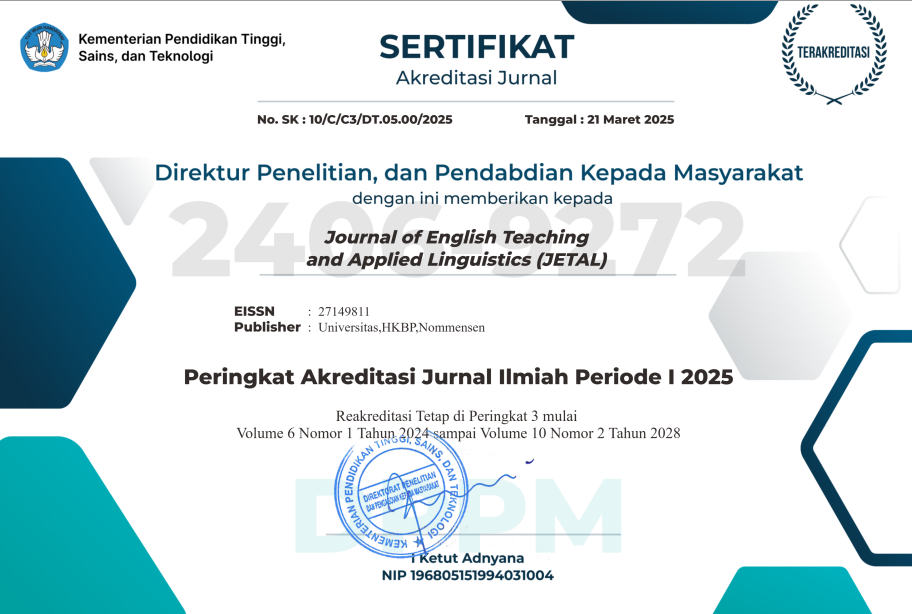A Review of Cognitive Approaches in SLA: Identifying the Most Influential Factors from Key Studies
Abstract
This study investigates cognitive approaches to Second Language Acquisition (SLA) by examining key components: attention, working memory, L1 transfer, and cognitive restructuring. Despite extensive research on individual cognitive factors in SLA, there remains a critical gap in understanding how these elements interact systemically in multilingual contexts, particularly in Indonesian EFL classrooms where traditional teaching methods often neglect cognitive principles. This study aims to develop an integrated cognitive model of SLA and propose practical pedagogical strategies tailored to Indonesia’s unique multilingual environment. A systematic review is conducted using the SALSA framework (Search, Appraisal, Synthesis, and Analysis), incorporating NVivo 12-assisted thematic analysis of ten peer-reviewed studies published between 2018 and 2023. The methodology follows PRISMA 2020 guidelines for transparent study selection and applies qualitative analysis to identify patterns across diverse cognitive studies. The findings reveal that attention serves as a gateway for input processing and learning, while working memory determines learners’ capacity to handle linguistic information. Additionally, L1 transfer either facilitates or hinders L2 learning depending on language distance and learner awareness. Cognitive restructuring enables proceduralization of explicit knowledge. In the Indonesian EFL context, these mechanisms are especially relevant. This study suggests cognitively informed instruction to enhance learning outcomes.
References
Bonvin, A., Brugger, L., & Berthele, R. (2023). Lexical measures as a proxy for bilingual language dominance? IRAL - International Review of Applied Linguistics in Language Teaching, 61(2), 257–285. https://doi.org/10.1515/iral-2020-0093
Booth, A., Sutton, A., & Papaioannou, D. (2012). Systematic approaches to a successful literature review. Sage.
Bradlow, A. R. (2022). Information encoding and transmission profiles of first-language (L1) and second-language (L2) speech. Bilingualism: Language and Cognition, 25(1), 148–162. https://doi.org/10.1017/S1366728921000717
Coumel, M., Ushioda, E., & Messenger, K. (2023). Second language learning via syntactic priming: Investigating the role of modality, attention, and motivation. Language Learning, 73(1), 231–265. https://doi.org/10.1111/lang.12522
Cunnings, I. (2022). Working memory and L2 sentence processing. In A. Baddeley, M. J. Kane, & N. Cowan (Eds.), The Cambridge handbook of working memory and language (pp. 593–612). Cambridge University Press. https://doi.org/10.1017/9781108955638.033
DeKeyser, R. (2020). Skill acquisition theory and the role of practice in L2 development. In Z.-H. Han & N. C. Ellis (Eds.), Implicit and explicit learning of languages (pp. 137–161). John Benjamins.
Ellis, N. C. (2019). Cognitive perspectives on SLA: The CREED framework. The Modern Language Journal, 103(S1), 61–79.
Gafur Marzuki, A., Nuraeni Silfani, A., & Al Viyani, V. (2024). Native language interference in EFL students’ writing of reflective journal in Indonesia. Journal of English Education and Teaching, 8(3),528–551. https://doi.org/10.33369/jeet.8.3.528-551
Godfroid, A. (2020). The effects of implicit instruction on attention to L2 form. In S. M. Gass, P. Spinner, & J. Behney (Eds.), Salience in SLA (pp. 169–192). Routledge.
Godfroid, A., Finch, B., & Koh, J. (2024). Reporting eye-tracking research in second language acquisition and bilingualism: A synthesis and field-specific guidelines. Language Learning. https://doi.org/10.1111/lang.12664
Goo, J. (2012). Corrective feedback and working memory capacity in interaction-driven L2 learning. Studies in Second Language Acquisition, 34(3), 445–474. https://doi.org/10.1017/S0272263112000149
Haddaway, N. R., Page, M. J., Pritchard, C. C., & McGuinness, L. A. (2022). PRISMA2020: An R package and Shiny app for producing PRISMA 2020-compliant flow diagrams, with interactivity for optimised digital transparency and Open Synthesis Campbell Systematic Reviews, 18, e1230. https://doi.org/10.1002/cl2.1230
Leow, R. P., & Donatelli, L. (2023). Noticing gaps in SLA: An eye-tracking study. Studies in Second Language Acquisition, 45(1), 85–107.
Li, S. (2022). Working memory and second language learning. In Z. Wen & S. Li (Eds.), The Routledge handbook of second language acquisition and psycholinguistics (pp. 348–360). Routledge. https://doi.org/10.4324/9781003018872-32
Li, C., & Gollan, T. H. (2021). What cognates reveal about default language selection in bilingual sentence production. Journal of Memory and Language,118,104214. https://doi.org/10.1016/j.jml.2020.104214
Lotfi, F., Afghah, F., & Ashdown, J. (2023). Attention-based open RAN slice management using deep reinforcement learning. arXiv preprint. http://arxiv.org/abs/2306.09490
Manchón, R. M., McBride, S., Mellado Martínez, M. D., & Vasylets, O. (2023). Working memory, L2 proficiency, and task complexity: Independent and interactive effects on L2 written performance. Studies in Second Language Acquisition, 45(3), 737–764. https://doi.org/10.1017/S0272263123000141
Maruf, N., Liu, Y., Halyna, K., Anwar, K., & Santoso, R. A. (2025). Enhancing language learning through gesture-based corrective feedback: A comparative study in a multi-country context. Indonesian Journal of Applied Linguistics,14(3),612–625. https://doi.org/10.17509/ijal.v14i3.74501
Heriyawati, D. F., Saukah, A., & Widiati, U. (2018). Working memory capacity, content familiarity, and university EFL students’ reading comprehension. Indonesian Journal of Applied Linguistics, 8(1),21–27. https://doi.org/10.17509/ijal.v8i1.11458
Pavlekovic, R., & Roehr-Brackin, K. (2024). Aptitude for explicit and implicit learning. Journal of the European Second Language Association, 8(1), 1–17. https://doi.org/10.22599/jesla.117
Pawlak, M., & Aronin, L. (n.d.). Second language learning and teaching: Essential topics in applied linguistics and multilingualism. Springer. http://www.springer.com/series/10129
Page, M. J., McKenzie, J. E., Bossuyt, P. M., Boutron, I., et al. (2021). The PRISMA 2020 statement: an updated guideline for reporting systematic reviews. BMJ, 372, n71.
Popovych, I., Hulias, I., Serbin, I., Piletskа, L., Mashchak, S., & Zahrai, L. (2023). Psychological content parameters of attention in the structure of time perspective of young female athletes: Comparative analysis. Journal of Physical Education and Sport, 23(1), 152–161. https://doi.org/10.7752/jpes.2023.01019
Puig-Mayenco, E., Rothman, J., & Westergaard, M. (2020). The role of L1 in L3 acquisition: A generative approach. Second Language Research, 36(1), 3–24.
Roehr-Brackin, K. (2024). Explicit and implicit knowledge and learning of an additional language: A research agenda. Language Teaching, 57(1), 68–86. https://doi.org/10.1017/S026144482200026X
Roehr-Brackin, K. (2021). Metalinguistic awareness and cognitive flexibility in L2 learning. Language Awareness, 30(1), 1–20.
Sagarra, N., & Ellis, N. C. (2021). The role of WM in implicit and explicit L2 learning. Language Learning, 71(S1), 167–205.
Schmidt, R. (1990). The role of consciousness in second language learning. Applied Linguistics, 11(2), 129–158. https://doi.org/10.1093/applin/11.2.129
Suzuki, Y., & DeKeyser, R. (2022). Explaining the efficacy of practice for L2 learning. Language Teaching, 55(2), 147–161.
Thi, N., & Nhung, P. (2020). Noticing hypothesis in second language acquisition. IOSR Journal of Humanities and Social Science, 25(6), 26–30. https://doi.org/10.9790/0837-2506012630
Wen, Z., & Li, S. (2019). Working memory and L2 sentence processing. Studies in Second Language Acquisition, 41(4), 721–747.
Westergaard, M. (2021). L3 acquisition and crosslinguistic influence as co-activation: Response to commentaries on the keynote ‘Microvariation in multilingual situations: The importance of property-by-property acquisition.’ Second Language Research, 37(3), 501–518.
Zhao, X., & Wang, D. (2023). Grit in second language acquisition: A systematic review from 2017 to 2022. Frontiers in Psychology,14. https://doi.org/10.3389/fpsyg.2023.1238788

This work is licensed under a Creative Commons Attribution-ShareAlike 4.0 International License.
Authors retain copyright and grant the journal right of first publication with the work simultaneously licensed under a Creative Commons Attribution-ShareAlike 4.0 International License (CC BY-SA 4.0) that allows others to share the work with an acknowledgment of the work's authorship and initial publication in this journal.
Authors are able to enter into separate, additional contractual arrangements for the non-exclusive distribution of the journal's published version of the work (e.g., post it to an institutional repository or publish it in a book), with an acknowledgment of its initial publication in this journal.
Authors are permitted and encouraged to post their work online (e.g., in institutional repositories or on their website) prior to and during the submission process, as it can lead to productive exchanges, as well as earlier and greater citation of published work (See The Effect of Open Access).





